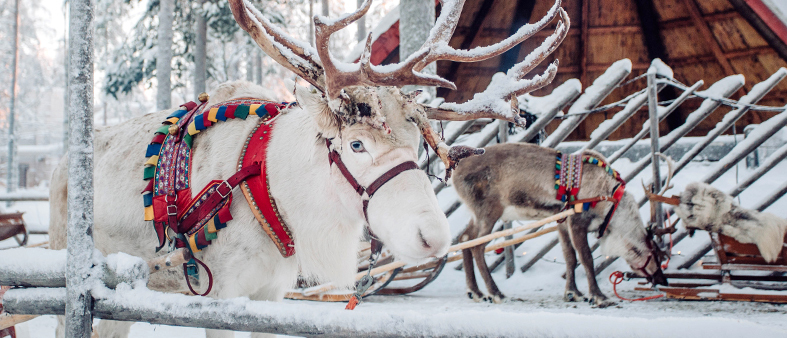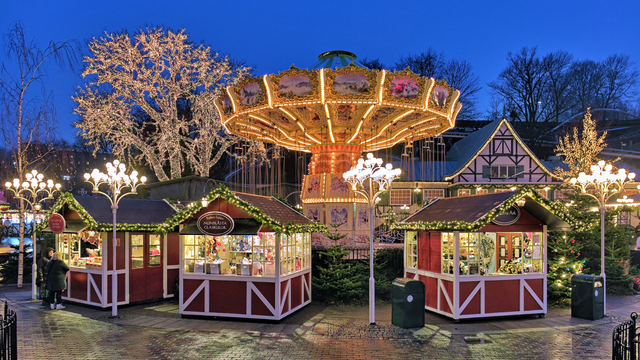
Nordic and Scandinavian Holiday Yule Traditions
When thinking of the winter holidays, one often pictures warm fires, landscapes blanketed with snow, and cozy scenes of people joined together to celebrate the year with good food and cheer. Few people in the world snuggle into that cozy feeling like the people of Scandinavia and the Nordics, and it’s easy to understand why. Some parts of the Nordic region are plunged into the darkness of polar night for months at a time. With endless mountains of snow, bone-chilling temperatures, and days with more twilight than sun, staying warm and bright is a necessity. Let’s learn more about the Christmas and winter holiday traditions of the Nordics and maybe take some inspiration to get through our own chilly months.
A Note About Religion in Scandinavia and the Nordics
Many people in Scandinavia and the Nordics identify as Lutheran Christian, and their cultural holiday traditions are heavily influenced by Christian practices. Islam is the second most practiced faith in the region.
Before the Christianization of the region, Jul (Yule) was celebrated to mark the winter solstice with the drinking of ale and the sacrifice of cattle to the Æsir (Norse gods). Some Jul customs remain in practice today, though the bloody sacrifice has been replaced with a hearty, meat-centered meal.
Nordic Winter Markets

In the Nordics, as in most regions of Europe, winter markets are held during the cold months, a tradition slowly regaining popularity in the United States. Usually, these are outdoor markets with tiny vendor huts full of handmade gifts. People bundle up to visit the markets, taking shelter under blankets, and drinking mulled wine.
Christmas in Sweden
In Sweden, Christmas is a generous celebration. They start by lighting the first of four candles on Advent Sunday, four Sundays before Christmas. Homes and storefronts are decorated with evergreen boughs, straw ornaments, and plenty of candles. It gets dark by mid-afternoon, so anything that brings light is welcome this time of year.
On December 13th, Swedes celebrate St. Lucia’s day, with candlelit processions led by a young woman dressed in white with a candle crown atop her head
In Swedish tradition, a gnomelike being called tomten or jultomten brings presents, not unlike Santa Claus. Presents are opened on Christmas Eve after the sun sets, and everyone celebrates with a type of smorgasboard called a julbord (Yule board), a five-course buffet of smoked and preserved fish, julskinka (a special Christmas ham), various other types of meat, cabbage, and potatoes. The feast is not complete without dopp i grytan, in which bread is soaked in the stock of the julskinka and consumed.
Swedes take baked goods very seriously, particularly around Christmastime. Saffron buns called lussekatt are baked, and pepparkakor (gingerbread cookies) are prepared in star and goat shapes. All washed down with hefty sips of glögg, a type of Swedish mulled wine.
The Swedish holiday season ends on January 13th with the celebration of St. Knut’s Day, often marked with a Knut’s party, named after King Canute IV, the patron saint of Denmark. This day is also known as Julgransplundring, “Christmas tree plundering,” or, Kasta ut granen, “Throw out the Tree,” as this is the day most Swedes take down and dispose of their Christmas trees, often by throwing them out the window!
Holiday Traditions in Norway
The celebration of the holiday season in Norway starts in November, usually with the hosting of a Julebord banquet. Though traditionally a banquet served at home, these days the dinner is more often held by employers, generally at a restaurant or catered venue.
Decorations of spruce and fir boughs are left on doorsteps, and a sheaf of wheat is often hung outside. It’s common to see the Julebukk (Yule Goat), a goat figurine made of straw representing the Norse god Thor’s magical goats that pulled his chariot through the sky.
On the remote Norwegian island of Svalbard, an island close to the north pole, all the people of the village of Longyearbyen gather on the first Sunday of Advent to light the Christmas tree. They then walk together out of town to a special letter box where people can send their Christmas wish lists to Julenissen (Norwegian Santa Claus). Light and cheer are very important on Svalbard as they experience 84 days of complete darkness during the polar night.
In Norway, gifts are opened on Julaften (Christmas Eve), and Julaften dinner is served at 5pm while the church bells ring to symbolize that Christmas is here. The traditional Norwegian Julaften foods vary by region.
In the north and west, pinnekjøtt (smokey, salted cured, steamed mutton ribs) is served. In eastern and central Norway, roasted pork ribs are common, served with dumplings and sausage called medisterkaker and medisterpølser. In the south, they eat Lutefisk, a type of preserved salt cod, and for dessert, they enjoy a dish of riskrem (rice porridge with whipped cream and lingonberry sauce). To drink there is Christmas beer, shots of aquavit, or julebrus, a special holiday soda.
Christmas Day is reserved for spending time with close family. A lunch called Første Juledags Frokost is held with a spread of meats, fish, cheeses, jams, and a selection of traditional pastries and breads called the julebakst. The following day, friends are often invited over to help finish up the feast. The official end of the Norwegian holiday season is commonly their celebration of St. Kunt on January 7th, but January 13th, known as gisladag or Tjuendedag is also a popular ending day.
Celebrating Christmas in Denmark
As in Sweden and Norway, Christmas in Denmark starts at the beginning of Advent, with Juleaften (Christmas eve) as the main event. An evening meal of roast pork, duck, or goose is served with brown gravy, potatoes in caramelized sauce, and cabbage. A cold rice pudding called risalamande is served with hot cherry sauce and one special almond. Whoever finds the almond in their dish gets a marzipan pig as a gift. After supper, it’s traditional to sing and dance around the Juletræ (Christmas tree) and drink plenty of mulled wine known as Gløgg.
During December, a Julefrokost (Yule lunch) is held, usually by employers, schools, or communities, while Familiejulefrokost (Family Yule lunch) is reserved for the close family on Christmas Day. Most luncheons begin with seafood dishes like pickled herring and smoked salmon on rugbrød (Danish rye bread), followed by various hot and cold meats, and plenty of schnapps and beer. Cheeses and fruit are served for dessert, along with more risalamande, småkager (Danish cookies), and nuts.
Danish children know Santa Claus as Julemanden (The Yule Man), who is assisted by julenisser (Yule elves), for whom children leave out saucers of milk and risalamande on Christmas Eve. Homes are decorated with paper and cardboard julehjerter (Yule hearts) and kravlenisser (climbing elves).
Finnish Holiday Celebrations
In Finland, the winter holidays begin a bit later than in Norway, Sweden, or Denmark. Finnish celebrations start on December 21st and continue to St. Knut’s Day on January 13th.
Rather than celebrating Yule, Finnish Christmas was adapted from the ancient harvest festival of kekri, traditionally held on November 1st. During kekri, a man would dress as the joulupukki (Christmas goat) with goat horns, a sheepskin coat, and a mask made of birch bark. In modern times, this tradition is recognized by the decorations of straw goats and the hanging of the himmeli (a geometric mobile made of straw).
Evergreen boughs are hung, trees are put up, and ice lanterns and torches can be found outside. Everywhere you can hear the sound of Christmas music, and in fact, singing Christmas carols is so important to Finns that most popular Finnish musical artists have made at least one Christmas album.
In Turku’s Old Market Square, a declaration of Christmas peace is made, a tradition dating back to the 17th century declaring 20 days of peace for all Finnish people. Finns often visit saunas on Christmas Eve and leave gifts of food and drink for the elves.
Finns will also leave gifts and lit candles on the graves of loved ones to honor them on Christmas Eve. Feeding birds has long been a Finnish holiday tradition, and Finns will hang decorations for the birds on evergreen trees in the forest, usually balls of suet and birdseed.
The Finnish Christmas feast consists of smoked and preserved fish, ham, and casseroles made of swede (rutabega), carrots or potato, and rice porridge and gingerbread served with glögi (Finnish mulled wine).
Yule in Iceland
The prize for the most interesting winter holiday traditions must go to Iceland. The Icelandic holiday of Jól spans Advent to January 6th and includes some fascinating lore.
Thirteen days before Aðfangadagur (Christmas Eve), Icelandic children leave their shoes by the window for the jólasveinarnir (the Yule Lads) to leave presents in. Good children get candy, while naughty children have their shoes filled with potatoes. Getting a potato is doubly bad because Icelanders consider their word for potato, kartafla, one of the ugliest words to say in the Icelandic language.
There are thirteen jólasveinarnir, each known for their specific brand of mischief, such as stealing different foods, licking pots or spoons, slamming doors, and eating candles. They are the sons of the witch troll Grýla, a terrifying being who will take naughty children and boil them alive in her giant cauldron.
As if that’s not motivation enough to finish their chores, children are also told tales of Jólakötturinn (the Yule cat), who will eat them if they don’t get new clothes before Christmas night.
In Iceland, the winter holidays are extensive, with many days to celebrate. Winter officially begins on Fyrsti Vetradagur (First Day of Winter), which is celebrated on Saturday between October 21st and 27th, and after that comes Jólabókaflóðið (Yule book flood) in November, when the Icelandic book list is published, and Icelanders buy each other books to give on Christmas Eve.
Then comes Dagur Íslenskrar Tungu (Icelandic Language Day) on November 16th. December 1st is Icelandic Sovereignty Day to celebrate Iceland’s sovereignty from Denmark. Then the jólasveinarnir come to make their mischief.
Next, is Þorláksmessa (St. Þórlákur’s Mass) on December 23rd, where brave souls will eat skata, a putrid, horrible smelling, fermented dish made of skate fish, washed down with plenty of Brennivín (Iceland’s official schnaps).
Then finally, Aðfangadagur (Christmas Eve) and Jóladager (Christmas day). The church bells will ring at 6pm on Aðfangadagur, signaling that Christmas has officially begun, and everyone will feast and then open their presents. It’s popular to give books as gifts on Aðfangadagur, which were purchased during the Jólabókaflóðið.
The traditional Icelandic Jóladager dinner usually includes hangikjöt (a type of smoked lamb) and ptarmigan (an Icelandic pheasant) and often smoked pork loin, all served with pickled cabbage, peas, beans, gravy, potatoes glazed in a sweet sauce. Families make their own special kind of laufabrauð (leaf bread), a type of crispy flat bread served with powdered sugar, and jólasmákökur (Yule cookies) like piparkökur (ginger snaps). As in other Nordic countries, a rice pudding called möndlu grautur is also served.
New Year’s Eve is known as Gamlársdagur in Iceland and features huge bonfires and fireworks displays that keep everyone awake until late at night. More fireworks are let off on Þrettándinn (thirteenth night) to end the Jól season.
Give The Gift Of Language This Holiday Season
Pimsleur Nordic and Scandinavian Language Lessons make a great gift for everyone on your list
For language lovers, frequent travelers, heritage learners, and aspiring polyglots, the holiday season just got more exciting! Give the gift that keeps on giving.
No Comments for "A Very Nordic Christmas – How to Celebrate Like a Scandinavian"